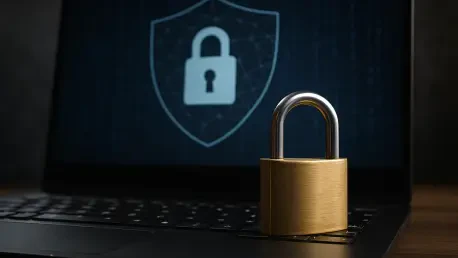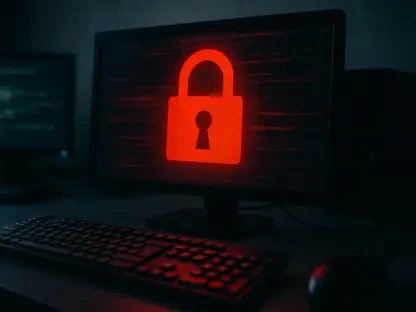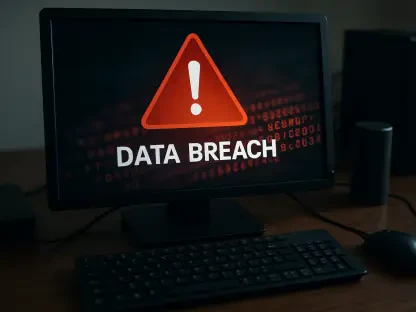In an era where cyber threats loom larger than ever, a staggering statistic reveals that edge devices like firewalls and web application firewalls (WAFs) are increasingly becoming prime targets for attackers, with a reported surge in exploitation attempts over the past year. Fortinet, a leading name in network security, finds itself at the center of this storm with the recent disclosure of a zero-day vulnerability in its FortiWeb WAF product line, identified as CVE-2025-58034, alongside another critical flaw, CVE-2025-64446. This roundup dives into the unfolding crisis, gathering opinions, analyses, and actionable advice from various industry sources to shed light on the severity of these vulnerabilities, Fortinet’s response, and the broader implications for cybersecurity. The purpose is to distill diverse perspectives into a cohesive narrative, helping stakeholders navigate the challenges posed by these flaws and strengthen their defenses.
Unpacking the FortiWeb Zero-Day Vulnerabilities
Technical Insights on CVE-2025-58034
The latest vulnerability, CVE-2025-58034, classified as a medium-severity OS command injection flaw with a CVSS score of 6.7, has raised significant concerns within the cybersecurity community. This issue allows authenticated attackers to execute arbitrary code through carefully crafted requests, exploiting improper neutralization of special elements in the system. Industry analyses indicate that the flaw, though requiring authentication, still poses a substantial risk due to its potential for remote exploitation under specific conditions.
Data from security researchers highlights the scale of the threat, with detection instances numbering around 2,000 shortly after disclosure. This figure underscores how quickly attackers have moved to leverage the vulnerability, catching many organizations off guard. The technical depth of the flaw suggests that patching alone may not suffice if access controls are not tightened concurrently.
Criticism has also emerged around the timing and manner of the patch release, with some industry voices pointing out that Fortinet addressed the issue in earlier updates without immediate public notification. This practice, often termed silent patching, has sparked debates about whether such approaches compromise the speed and effectiveness of defensive responses across affected networks.
Chained Exploits and Rising Threats
Beyond the standalone danger of CVE-2025-58034, reports from cybersecurity teams reveal a more alarming trend: attackers are chaining this flaw with another recent vulnerability, CVE-2025-64446, to orchestrate sophisticated exploitation campaigns. Such coordinated efforts amplify the potential damage, enabling deeper penetration into targeted systems. This strategy reflects a growing sophistication among threat actors who exploit multiple entry points for maximum impact.
The urgency of this situation is further evidenced by the U.S. Cybersecurity and Infrastructure Security Agency (CISA) adding CVE-2025-58034 to its Known Exploited Vulnerabilities catalog, mandating a tight one-week remediation window. This directive emphasizes the active exploitation already underway and the critical need for organizations to act swiftly to mitigate risks at their network perimeters.
The broader impact of these chained attacks extends to global enterprises relying on FortiWeb for protection, as compromised edge devices can serve as gateways to sensitive data and infrastructure. This dynamic has prompted a reevaluation of how security teams prioritize updates and monitor for unusual activity, especially in environments with high exposure to external threats.
Transparency Challenges in Vulnerability Handling
A significant point of contention among industry watchers is Fortinet’s approach to vulnerability disclosure, particularly the practice of silent patching and the assignment of a single CVE identifier to multiple related issues. Many argue that this lack of granular transparency hampers defenders’ ability to track and address specific threats accurately, creating gaps in response strategies.
Feedback from security vendors suggests a strong push for clearer standards in how vulnerabilities are communicated to the public. The concern is that without upfront disclosure, organizations remain unaware of risks until exploitation is already rampant, as seen with the rapid spread of attacks targeting these FortiWeb flaws. This perspective calls for a shift toward more immediate and detailed reporting mechanisms.
The debate also touches on trust, with some in the community questioning whether Fortinet’s current practices could erode confidence among users who depend on timely information to safeguard their systems. Alternative models of vulnerability management, such as proactive notifications and distinct identifiers for each issue, are often cited as potential improvements that could redefine industry norms.
Edge Devices as Critical Battlegrounds
The focus on FortiWeb vulnerabilities ties into a larger trend of escalating attacks on edge infrastructure, including firewalls and VPNs, which serve as the first line of defense for many networks. Cybersecurity analysts note that these devices are attractive targets for both cybercriminals and nation-state actors due to their pivotal role in securing network perimeters, especially in distributed work environments.
Comparative analyses with other vendors reveal that Fortinet is not alone in facing such challenges, as similar issues have surfaced across the sector. However, the frequency and severity of exploits targeting Fortinet products have positioned them as a focal point, prompting speculation about whether systemic solutions—such as enhanced testing protocols or collaborative threat-sharing platforms—are necessary to address these persistent risks.
This spotlight on edge security also hints at future innovation, with some suggesting that the ongoing pressure might drive advancements in how such devices are designed and protected. Conversely, others caution that without addressing root causes, like insufficient transparency or delayed patches, the industry risks perpetuating weaknesses that attackers will continue to exploit.
Diverse Opinions on Fortinet’s Response and Practices
Gathering insights from multiple corners of the cybersecurity landscape reveals a spectrum of views on how Fortinet has managed this crisis. Some industry observers express concern over the recurring nature of zero-day flaws in Fortinet’s product line, arguing that the pattern points to deeper issues in development or testing processes. They emphasize that repeated vulnerabilities could signal a need for more rigorous internal audits before products reach the market.
In contrast, other voices in the field acknowledge the complexity of maintaining security in widely deployed solutions like FortiWeb, suggesting that Fortinet’s challenges are partly a byproduct of its extensive user base, which naturally attracts more attacker attention. This perspective urges a balanced view, recognizing that while improvements are needed, the scale of deployment amplifies visibility of any flaws compared to smaller vendors.
A third angle focuses on actionable critique, with several security firms advocating for Fortinet to adopt a more open communication strategy. The consensus here leans toward immediate public alerts upon patch releases, paired with detailed breakdowns of affected components, to empower users with the information needed to act decisively. This diversity in opinion highlights the multifaceted nature of the issue, blending technical, strategic, and ethical considerations.
Practical Tips for Mitigating Risks
Amid the discussions, a wealth of practical advice emerges for organizations using Fortinet’s FortiWeb or similar edge security solutions. A primary recommendation is to update systems to the latest patched versions, such as FortiWeb 8.0.2 or 7.6.6, which address the identified vulnerabilities. Ensuring that updates are applied promptly can significantly reduce exposure to active exploits.
Another widely endorsed tip is to secure management interfaces by restricting access to trusted networks or implementing strong authentication measures. Exposing these interfaces to the internet has been flagged as a common misstep that attackers exploit, making it a critical area for immediate attention in any security review.
Finally, continuous monitoring for suspicious activity is advised as a proactive defense layer. Security teams are encouraged to leverage threat intelligence feeds and anomaly detection tools to spot potential breaches early, especially given the speed at which attackers have targeted these flaws. Combining these steps offers a robust framework for minimizing risks while broader industry practices evolve.
Reflecting on Key Takeaways and Next Steps
Looking back, the discourse surrounding Fortinet’s latest WAF zero-day crisis illuminated critical vulnerabilities in edge security, underscored by the active exploitation of CVE-2025-58034 and CVE-2025-64446. The varied opinions from industry sources painted a complex picture, balancing criticism of disclosure practices with recognition of the inherent challenges in securing widely used network solutions. Practical guidance, from timely patching to interface security, emerged as a unifying theme across perspectives.
Moving forward, organizations must prioritize not only the immediate remediation of these specific flaws but also the adoption of a more vigilant stance on edge device protection. Exploring collaborative platforms for real-time threat sharing could serve as a valuable next step, fostering resilience against evolving attack tactics. Additionally, pushing for industry-wide standards on transparency might help address systemic issues, ensuring that vendors and users alike are better equipped to handle future crises with confidence.









